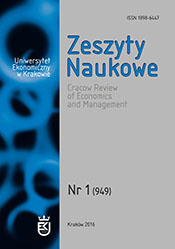Miarkowanie odszkodowania za utracone dochody z wykorzystaniem prognozy dochodów
DOI:
https://doi.org/10.15678/ZNUEK.2016.0949.0103Słowa kluczowe:
renta, świadczenie odszkodowawcze, finanse osobiste, szkody osoboweAbstrakt
Wysokość odszkodowania, które powinna otrzymać osoba poszkodowana, składa się z kilku elementów. Jednym z nich, gdy poszkodowany nie jest zdolny do pracy, jest wysokość dochodów, które utracił. Aby odszkodowanie było dobrze ustalone, warto posłużyć się w jego ustalaniu wartością pieniądza w czasie i dynamiką wzrostu wynagrodzeń w sektorze, w którym pracował poszkodowany. Należy również wziąć pod uwagę inflację. W artykule przeprowadzono symulacje pokazujące różnice między podejściem, które nie uwzględnia wymienionych czynników, a podejściem, które te czynniki uwzględnia. Pierwsze podejście jest często używane przez polski wymiar sprawiedliwości w ustalaniu wysokości renty odszkodowawczej. Drugie jest propozycją lepszego zabezpieczenia osoby poszkodowanej, która utraciła zdolność do pracy.
Downloads
Bibliografia
Anderson G.A., Roberts D.L. [1989], Stability in the Present Value Assessment of Lost Earnings, „Journal of Risk and Insurance”, vol. 56(1).
Bryan W., Linke C.M. [1988], The Estimation of the Age/Earnings Profiles in Wrongful Death and Injury Cases: Comment, „The Journal of Risk and Insurance”, vol. 55(1).
Gilbert R.F. [1994], Estimates of Earnings Growth Rates Based on Earnings Profiles, „Journal of Legal Economics”, vol. 4(2).
Gilbert R.F. [1997], Long-term and Short-term Changes in Earnings Profiles, „Journal of Forensic Economics”, vol. 10(1).
Gohmann S.F., McCrickard M.J., Slesnick F. [1998], Age-earnings Profiles Estimates: Do They Change over Time?, „Journal of Forensic Economics”, vol. 11(3).
Haberman S., Bloomfield D. [1990], Work Time Lost to Sickness, Unemployment and Stoppages: Measurement and Application, „Journal of the Institute of Actuaries”, vol. 117(3).
Kucsma K.K., Tinari F.D. [2010], Assessing Economic Damages in Personal Injury and Wrongful Death Litigation: The State of New Jersey, „Journal of Forensic Economics”, vol. 21, nr 2, June, http://www.tinarieconomics.com/sites/default/files/pdfs/assessing_economic_damages.pdf (dostęp: 3.04.2015).
Lane J., Glennon D. [1985], The Estimation of Age/Earnings Profiles in Wrongful Death and Injury Cases, „Journal of Risk and Insurance”, vol. 52(4).
Lewis R., McNabb R., Robinson H., Wass V.J. [2002], A Comparison of Two Alternative Methods for Determining Loss of Future Earnings in Personal Injury Cases, Presented at Royal Economic Society Annual Conference 2002, Warwick, UK, 25–27 March.
Luckett N., Craner J. [1994], Multipliers: Are the Courts Being Fair to Claimants?, „Journal of Personal Injury Litigation”, nr 5.
Minnchan R. [2009], Examples of “Schedules of Damages” Used in Europe and the United States [w:] Personal Injury and Wrongful Death Damages Calculations: Transatlantic Dialogue, red. J.O. Ward i R.J. Thornton, „Contemporary Studies in Economic and Financial Analysis”, vol. 91(2009).
Mullet M.J., Nelson D.M., Patton R.T. [1990], Alternative Measures of Earnings Growth, „Journal of Forensic Economics”, vol. 3(1).
Nelson D.M., Patton R.T. [1990], Measuring Earnings Growth in the U.S., „Journal of Legal Economics”, vol. 3(3).
Ritchie D. [1994], Smith v Manchester Awards: How Do Courts Assess Loss of Capacity on the Labour Market, „Journal of Personal Injury Litigation”.
Rodgers J.D., Brookshire M.L., Thornton R.J. [1996], Forecasting Earnings Using Age-earnings Profiles and Longitudinal Data, „Journal of Forensic Economics”, vol. 9(2).
Smith S.J. [1982], New Worklife Estimates Reflect Changing Profile of Labor Force, „Monthly Labor Review”, vol. 105(3).
Spizman L., Tinari F.D. [2011], Assessing Economic Damages in Personal Injury and Wrongful Death Litigation: The State of New York, „Journal of Forensic Economics”, vol. 22, nr 1, June, http://www.tinarieconomics.com/sites/default/files/pdfs/Assessing%20Economic%20Damages%20in%20NY%20%28jfe.22.1.75%29.pdf (dostęp: 3.04.2015).
Thornton R.J., Rodgers J.D., Brookshire M.L. [1997], On the Interpretation of Age-earnings Profiles, „Journal of Labour Research”, vol. 18(2).
Tinari F., Cahill K.E., Grivoyannis E. [2006], Did the 9/11 Victim Compensation Fund Accurately Assess Economic Losses?, „Topics in Economic Analysis and Policy”, vol. 6, nr 1, January, http://www.tinarieconomics.com/sites/default/files/Victim%20Compensation%20Fund.pdf (dostęp: 5.04.2014).
Ward J.O. [2009], Economic Damages and Tort Reform: A Comparative Analysis of the Calculation of Economic Damages in Personal Injury and Death Litigation in the United States and the United Kingdom [w:] Personal Injury and Wrongful Death Damages Calculations: Transatlantic Dialogue, red. J.O. Ward i R.J. Thornton, „Contemporary Studies in Economic and Financial Analysis”, vol. 91, http://www.emeraldin-sight.com/books.htm?chapterid=1819487 (dostęp: 5.04.2014).




